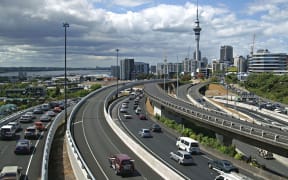Hundreds of Wellington commuters are benefiting from the country's first so-called smart motorway, which opened last month.
The system, which is used widely overseas, opened in June after months of construction.
There is an additional northbound lane; and sensors, cameras and bluetooth data are used to estimate the speed cars should be travelling to keep traffic flowing smoothly on a stretch of road that sees 90,0000 cars a day pass in and out of the city.
And motorists are helping make the road smarter. If their cellphones are bluetooth-activated an anonymous signal is sent to the system which the New Zealand Transport Agency then uses to work out how long a commute will take.
The project cost $55 million and runs between Johnsonville and the Terrace tunnel.
NZTA Wellington manager Neil Walker said, while it was still early days, the new system seemed to be working. Six hundred extra cars an hour were moving out of the city during the peak evening rush hour, he said.
The system will be operated by people for at least another six months and then computerised.
In the meantime, NZTA is fine-tuning the algorithm and ensuring things will function properly once it is handed over to the machines.
Mr Walker said the smart motorway was about keeping traffic moving, even if it went a bit slower.
A slower speed reduced the likelihood of sudden braking, which sends shockwaves through traffic.
Merging is another focus of the smart motorway; with the new system, people are encouraged not to change lanes unnecessarily and to merge like a zip at the end of the merging lanes.
Mr Walker said he thought the technology would eventually be rolled out in other cities. Wellington was used as a starting point because the road network was relatively simple compared with Auckland.
Automobile Association spokesperson Dylan Thompson said motorists wanted to see more technology on the roads, and those in the capital city were especially keen to start seeing the benefits after months of construction.




